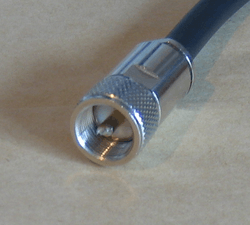UHF connector
|
PL-259 (male) plug. Outside diameter is about 18 mm. | |||
| Type | RF coaxial connector | ||
|---|---|---|---|
| Production history | |||
| Designer | E. Clarke Quackenbush | ||
| Designed | 1930s | ||
| Manufacturer | Various | ||
| General specifications | |||
| Diameter | 18 mm (0.71 in) (typical) | ||
| Cable | Coaxial | ||
| Passband | Typically 0–100 MHz | ||
| Connector |
SO-239 (socket)[1] PL-259 (plug) [2] | ||


The UHF connector[3] is a World War II or earlier[4][5] threaded RF connector design, from an era when "UHF" referred to frequencies over 30 MHz.[6][7][8]
Design and nomenclature
Originally the connector was designed to carry signals at frequencies up to 300 MHz,[3] but later measurements reveal limitations above 100 MHz.[9] The coupling shell has a 5⁄8 inch 24tpi UNEF standard thread.[3] The most popular cable plug and corresponding chassis-mount socket carry the old Signal Corps nomenclatures PL-259 (plug) and SO-239 (socket).[10] These are also known as Navy type 49190 and 49194 respectively.[11]
PL-259, SO-239, and several other related military references refer to one specific mechanical design collectively known as the UHF Connector.[3]
Characteristics
Mechanical
By design, all connectors in the UHF Connector family mate using the 5/8 inch 24 tpi threaded shell for the shield connection[3] and an approximately 0.156 inch (4mm) diameter pin and socket for the inner conductor. Similar connectors with an incompatible 16mm diameter, 1mm metric thread have been produced,[12] but these are not standard UHF connectors by definition.[3]
Surge impedance
UHF connectors have a non-constant surge impedance.[3] For this reason, UHF connectors are generally usable through HF and the lower portion of what is now known as the VHF frequency range.[9] Despite the name, the UHF connector is rarely used in commercial applications for today's UHF frequencies, as the non-constant surge impedance creates measurable electrical signal reflections above 100 MHz.[9][13][14]
Power
UHF connectors can handle RF peak power levels over one kilowatt based on the voltage rating of 500 volts peak.[3]
Environmental tolerance
The UHF connector is not weatherproof.[3]
Applications
In many applications, UHF connectors were replaced by designs that have a more uniform surge impedance over the length of the connector, such as the N connector and the BNC connector.[15] UHF connectors are still widely used in amateur radio, Citizens Band radio, and marine VHF radio applications.
See also
References
- ↑ US patent 2761110, Henry M Diambra, "Solderless Coaxial Connector", published 1956-08-28, assigned to Entron, Inc.
- ↑ US patent 4085366, Billy Padgett, "Noise reduction device for citizen's band transceivers", published 1978-04-18, assigned to Billy Padgett
- 1 2 3 4 5 6 7 8 9 "UHF Connector Series". Amphenol. Retrieved 23 September 2015.
- ↑ US patent 2335041, William A Bruno, "Right-angle electric connector", published 1943-11-23, assigned to Bruno Patents Inc
- ↑ US patent 2422982, Edward Clarke Quackenbush, "Coaxial cable connector", published 1947-06-24, assigned to Edward Clarke Quackenbush
- ↑ Dale Pollack (1941). "High-Frequency Transmission and Reception". In Henney, Keith. Radio Engineering Handbook (3rd ed.). New York and London: McGraw-Hill Book Company. p. 514.
- ↑ "(PL) 259 Connectors". Connectors. Hamradio.me. July 2011. Retrieved 16 May 2015.
- ↑ "Introduction to U.H.F.". The Radio Amateur's Handbook (18th ed.). West Hartford, CT: American Radio Relay League. 1941. pp. 362–363.
In Amateur work, the ultra-high-frequency region is considered to include the 56 to 60 Mc band and all higher frequency bands available for amateur use.
- 1 2 3 "‘UHF’ Connector Test Results". Connectors. Hamradio.me. October 2011. Retrieved 31 January 2012.
- ↑ TM 11-5820-348-15, ANTENNA EQUIPMENT RC-292. Department of the Army. 1966-04-23.
- ↑ MIL-HDBK 172A, Vol. I - Military Standardization Handbook, Electronic Test Equipment. Department of Defense. 1964-03-11.
- ↑ "Drawing of Metric Connector". RF Supplier. Retrieved 24 September 2015.
- ↑ US patent 2233166, William C Hahn, "Means for transferring high frequency power", published 1941-02-25, assigned to Gen Electric
- ↑ "The UHF type connector under network analysis". Chris's Amateur Radio and Electronics resource pages. Retrieved 31 January 2012.
[. . .] at 432 MHz [. . .] we see a loss in the order of 1.0 dB, this equates to a transmission loss of around 6 Watts with 25 Watts input.
- ↑ "Lab Tests: SMA, BNC, TNC and N Connectors". Connectors. Hamradio.me. August 2011. Retrieved 31 January 2012.
